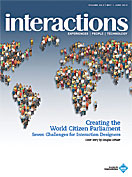Authors:
Yoichi Takahashi, Yasushi Matoba, Hideki Koike, Alvaro Cassinelli, Jussi Angesleva, Yoshihiro Watanabe, Gonzalo Frasca, Masatoshi Ishikawa, Matthew Hirsch, Shahram Izadi, Henry Holtzman, Ramesh Raskar, Quentin Bonnard, Amanda Legge, Anna Geiduschek, Frédéric Kaplan, Pierre Dillenbourg
Information is becoming accessible everywhere in everyday life due of the spread of smartphones and portable personal computers; however, there are very few methods to access content in a bathing environment. We propose an interactive water-surface display system, which uses image-recognition techniques. The system supports intuitive interactions peculiar to water, such as poking a finger up from under the water surface, stroking the water surface, and scooping up water.
Project website: http://youtu.be/bJo-xnebiy0
Publication: Takahashi, Y., Matoba, Y., and Koike, H. Fluid surface: Interactive water surface display for viewing information in a bathroom.
Proc. of the 2012 ACM International Conference on Interactive Tabletops and Surfaces. ACM, New York, 2012, 311-314.
Yoichi Takahashi | University of Electro-Communications | [email protected]
Yasushi Matoba | University of Electro-Communications | [email protected]
Hideki Koike | University of Electro-Communications | [email protected]
Skin Games explores the ludic possibilities opened up by harnessing the body not only as the controller (e.g., Kinect), but also as the support for displaying the game's output. Posture both triggers particular game actions and transforms the geometry and topology of the game level. Skin Games thus takes the concept of immersion to a whole new physical level: You are literally covered by the game's graphics. The fact that the user needs to contort to see the graphics on her own body is perceived here as an interesting feature of the proposed interaction paradigm.
Project website: http://www.k2.t.u-tokyo.ac.jp/perception/skinGames/ (related Laser Sensing Display technology: http://www.k2.t.u-tokyo.ac.jp/perception/SLP/)
Publication: Cassinelli, A., Angesleva, J., Watanabe, Y., Frasca, G., Ishikawa, M. Skin Games. Proc. of the ACM International Conference on Interactive Tabletops and Surfaces. ACM, New York, 2012, 323326.
Alvaro Cassinelli | University of Tokyo | [email protected]
Jussi Angesleva | The Berlin University of the Arts | [email protected]
Yoshihiro Watanabe | University of Tokyo | [email protected]
Gonzalo Frasca Universidad ORT Uruguay | [email protected]
Masatoshi Ishikawa | University of Tokyo | [email protected]
Imagine a display that behaves like a window. Glancing through it, viewers perceive a virtual 3-D scene with correct parallax, without the need to wear glasses or be tracked by the system. Light that passes through the display correctly illuminates the virtual scene. By simultaneously capturing and displaying a 4-D light field, we are able to realistically modulate the incident light on rendered content. Our hardware points the way toward novel 3-D interfaces, in which users interact with hyper-realistic digital projections using light widgets, physical objects, and gesture.
Project website: http://web.media.mit.edu/~mhirsch/8D
Publication: Hirsch, M., Izadi, S., Holtzman, H., and Raskar, R. 8D display: A relightable glasses-free 3D display. ACM SIGGRAPH 2012 Posters. ACM, New York, 2012, Article 34.
Hirsch, M., Izadi, S., Holtzman, H., and Raskar, R. 8D display: A relightable glasses-free 3D display. Proc. of the 2012 ACM International Conference on Interactive Tabletops and Surfaces. ACM, New York, 2012, 319322.
Matthew Hirsch | MIT Media Lab | [email protected]
Shahram Izadi | Microsoft Research UK | [email protected]
Henry Holtzman | MIT Media Lab | [email protected]
Ramesh Raskar | MIT Media Lab | [email protected]
 Paper Interfaces for Geometry Education
Paper Interfaces for Geometry Education
Paper provides a rich medium for interface design. It allows for a wide range of interaction techniques that build on established cultural practices: printing, writing, reading, folding, cutting, and tearing. Paper interfaces are especially relevant to education because they use paper (the dominant technology in classrooms) while mixing the advantages of computer-supported education and tangible interfaces. Using a camera-projector system, we explore the tangible properties of these interfaces within the adapted context of geometry education. Both teachers and pupils readily adopted these interfaces during classroom experiments, and teachers especially appreciated the flexibility provided to create their own augmented reality activities.
Project website: http://craft.epfl.ch/lang/en/PaperTangibleInterface
Publication: Bonnard, Q., Jermann, P., Legge, A., Kaplan, F., and Dillenbourg, P. Tangible paper interfaces: Interpreting pupils' manipulations. Proc. of the 2012 ACM international Conference on Interactive Tabletops and Surfaces. ACM, New York, 2012.
Bonnard, Q., Verma, H., Kaplan, F., and Dillenbourg, P. Paper interfaces for learning geometry. Proc. of 7th European Conference on Technology Enhanced Learning (Saarbrücken, Germany). 2012.
Quentin Bonnard | CRAFT, École Polytechnique Fédérale de Lausanne (EPFL) | [email protected]
Amanda Legge | CRAFT, École Polytechnique Fédérale de Lausanne (EPFL) | [email protected]
Anna Geiduschek | CRAFT, École Polytechnique Fédérale de Lausanne (EPFL) | [email protected]
Frédéric Kaplan | CRAFT, École Polytechnique Fédérale de Lausanne (EPFL) | [email protected]
Pierre Dillenbourg | CRAFT, École Polytechnique Fédérale de Lausanne (EPFL) | [email protected]
The Demo program at ITS 2012 allowed attendees to directly interact with and experience novel, interactive systems. Demonstrations were reviewed based on relevance, technological quality, and creativity.
The projects here were selected by Daniel Leithinger, a Ph.D. student at MIT Media Lab, Juergen Steimle, visiting faculty at MIT Media Lab, and Anthony Tang, assistant professor at the University of Calgary.
©2013 ACM 1072-5220/13/05 $15.00
Permission to make digital or hard copies of all or part of this work for personal or classroom use is granted without fee provided that copies are not made or distributed for profit or commercial advantage and that copies bear this notice and the full citation on the first page. To copy otherwise, to republish, to post on servers or to redistribute to lists, requires prior specific permission and/or a fee.
The Digital Library is published by the Association for Computing Machinery. Copyright © 2013 ACM, Inc.











Post Comment
@Robert (2015 06 20)
Absolutely amazing display that behaves like a window. I am very impressed for suitable display.
thanks a lot
@igloo app (2016 06 08)
This awesome, Thank you so much